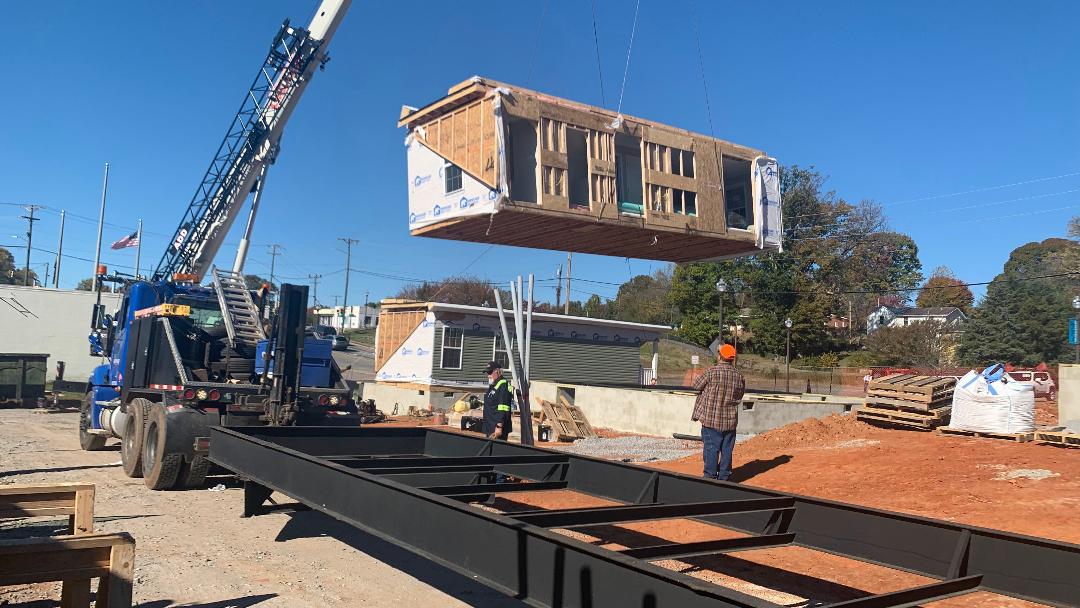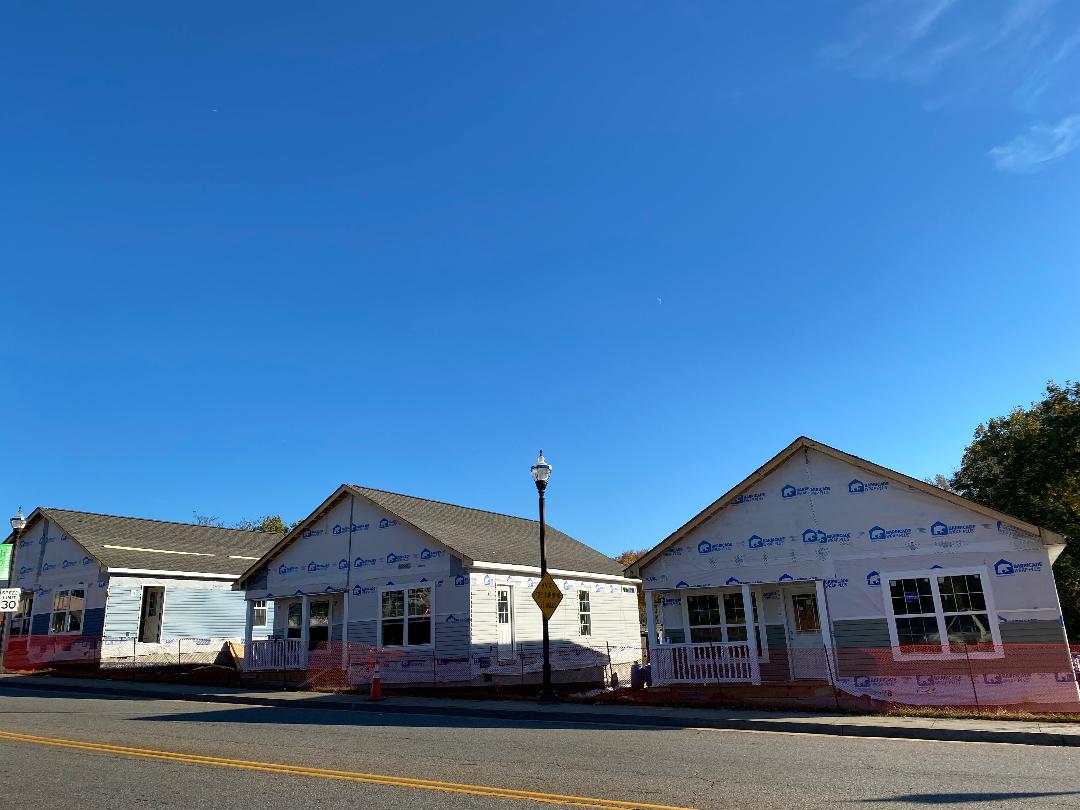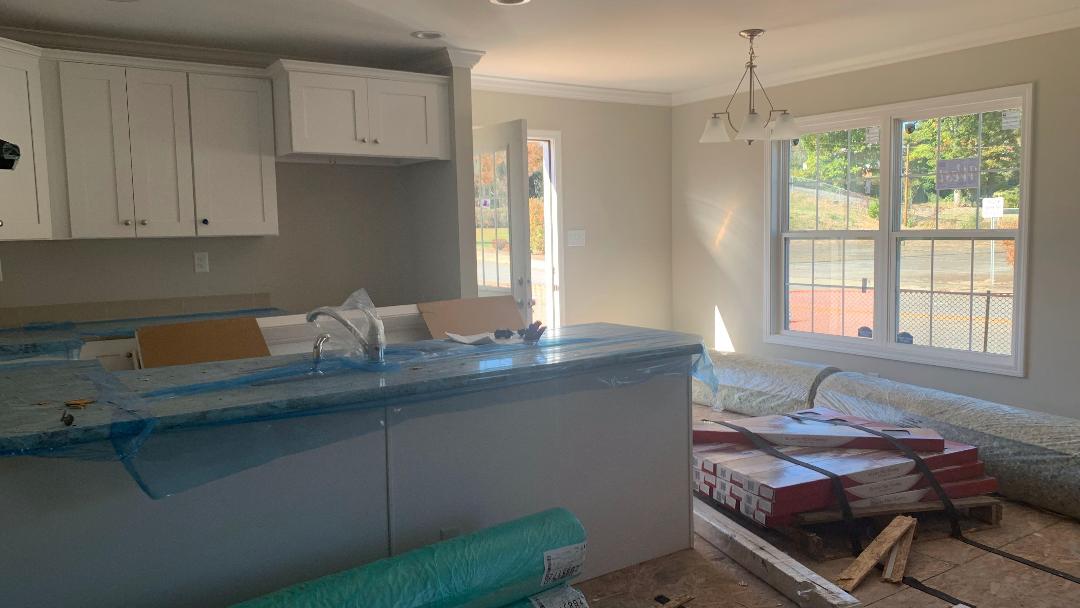
By Callie Hietala
The first three cottage-style homes recently were put in place in the new Five Points neighborhood project, which broke ground on Nov. 18 last year.
A total of 27 units, a mix of 12 cottages and 15 townhouses, are slated for construction on both sides of West Church Street, near the intersection of Fayette Street and Memorial Boulevard South in Martinsville. The new homes are within walking distance of the Uptown area.
The project is a partnership between the City of Martinsville, Nationwide Homes, Silverpoint Homes, the Martinsville-Henry County Economic Development Corporation, United Way of Martinsville-Henry County, the USDA- Rural Development, Virginia Housing, and the Harvest Foundation.

The first three cottages in the new affordable Five Points neighborhood were set in place last week. The affordable housing project is made possible through a partnership between Martinsville, Nationwide Homes, Silverpoint Homes, the Martinsville-Henry County Economic Development Corporation, United Way of Martinsville-Henry County, the USDA- Rural Development, Virginia Housing, and the Harvest Foundation.
The ranch-style cottage homes will be 995 square feet, with 2 bedrooms, 2 bathrooms, a porch, a separate dining area, a walk-in closet, and a hall closet. There are 2 styles of two-story townhouses slated for construction. The first is 1,106 square feet with 3 bedrooms and 1.5 bathrooms, a foyer, walk-in closet, pantry, and hall closet. The second is 1,216 square feet with 3 bedrooms, 1.5 bathrooms, a separate dining area, pantry, hall closet, and extended front porch.
Martinsville-Henry County Housing and Revitalization coordinator Jeff Sadler said the city originally hoped to sell the cottages for $125-130,000 but, due to the rising cost of supplies, these first houses are priced at $139,750.
“They were invoiced higher,” he said, “but we were able to move some funds around from various grants to get that under $140,000. We won’t know for sure what the cost of the next set is because it all depends on the cost of materials, which are, to some extent, coming back down. We’re hoping that we can at least be in that same ($140,000) range.”
Additionally, Sadler said “we hoped to have the townhomes available at around $145,000, but they will likely be in the $150-160,000 range, depending on materials costs and any other cost savings we can find.” However, it is still too early to provide an accurate number.
Five homes are being placed in this first round of construction. The homes were pre-built offsite, and the first ones were put in place last week. Final details, including siding, gutters, utility hookups, and interior work, are being completed on-site.

The unfinished interior of one of the cottage-style homes. (Courtesy of Nationwide Homes.)
The project began with a housing study which, Sadler said, showed a strong demand for newer housing, particularly at lower price points. The study indicated “half of the houses in the Martinsville and Henry County area are at least 50-years-old, and almost two-thirds of them are at least 40-years-old, so the housing stock has become outdated.
“A lot of these houses,” he added, “were built with a 40- or 50-year lifespan. They were workforce housing, not expected to last 100 years.”
This project, he said, puts new housing stock in place that is specifically targeted to the area’s workforce.
“One of the things we’re hearing from employers is they’re having trouble attracting and keeping employees, and one of the reasons is there isn’t much appropriate housing, so people end up finding a place to live in Greensboro or Danville or Roanoke. Eventually, they get tired of the drive and find a job there, so we’re trying to replenish the housing stock so there are good options for people here,” Sadler said.
City Manager Leon Towarnicki said the houses are geared toward someone making around $20 an hour. He estimated that taxes and utilities for the entire neighborhood, once completed, will result in annual revenues of $120,000 for the city.
Sadler said that there are some income restrictions imposed on potential homebuyers in the new neighborhood to ensure the homes are available for lower income homebuyers to purchase.
Partnerships between the city and entities that include the USDA-Rural Development and United Way, are intended to help make the homes affordable and to help buyers find a payment plan that works for them.
“If you were to buy these houses, purchase the land and get them all set, these would be $175,000 each. But because the city’s donating the land, some administrative costs, Harvest is donating administrative costs and serving as fiscal agent for the project,” costs are relatively low, he said.
The USDA-Rural Development has “some mortgage programs that allow for a 33- or 38-year amortization, so instead of being a 30-year mortgage, stretching it out a couple more years make it a little more affordable on a monthly basis,” Sadler said, adding that the programs also include low down payments and reduced interest rates.
When combined with Virginia Housing programs which, Sadler said, qualify borrowers for USDA loans, “you could get into one of these houses for basically a payment on a nice car.”
He added that Virginia Housing gave a $500,000 grant to the project, a good portion of which went toward prepping the area for the placement of the houses.
Sadler said the United Way has a savings match program for people with lower incomes called Virginia Individual Development Accounts (VIDA).
“They do some financial literacy classes, but it’s an 8 to 1 match,” so if someone enrolled in the program saves $500 over six months, “they can get matched with $4,000, which comes out to about 3 percent of the price of one of these homes,” Sadler said, and noted that most first-time homebuyers have a 3 percent down payment requirement, “so you can save your down payment pretty easily if you follow the rules of the program.”
Towarnicki told city officials that there has been a “considerable amount of interest” from potential homebuyers since construction began.
Selling the homes is a key part of moving the construction process forward.
“The more homes we get purchased, the more we can build,” Sadler said.
The plan is to build in phases, constructing roughly five houses at a time. Once most of the first set are sold, that money will be funneled into construction of the next set and so on until, eventually, a new neighborhood of affordable, modern housing is complete.



